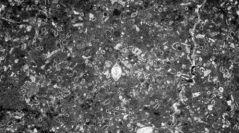

 Geodiversitas
25 (2) - Pages 217-235
Geodiversitas
25 (2) - Pages 217-235The pelagic Jurassic successions of Western Sicily are dominated by the Tethyan Rosso Ammonitico. In the eastern sector of Monte Inici this lithofacies has been deposited during the Callovian-upper Berriasian interval. In the southwestern and northwestern sectors, it reached the middle Oxfordian and was followed by the deposition of silicified limestones which form a lateral equivalent of Tethyan radiolarites. The base of the studied pelagic succession reveals a high energy environment during the Callovian. It is followed by a low energy period until the upper Kimmeridgian-Berriasian interval, characterised by an intense and cyclic hydrodynamism. This energy decreases during the end of the Berriasian time. During the middle-upper Oxfordian a positive d 13 C peak (d 13 C = + 3 [[perthousand]]) coincides with the highest skeletal diversity, the appearance of the nodular facies in Monte Inici East and the deposition of the silicified limestones in the southern zone. This peak indicates a high biological productivity. On the other hand, the Planula Zone (upper Oxfordian) is characterised by a relative negative excursion of the d 13 C curve (+ 2.3 [[perthousand]]), a decrease of the biodiversity and the local disappearance of protoglobigerinids. The fluctuations of the d 13 C curve are interpreted as variations of global palaeoenvironmental conditions. The heteropy Rosso Ammonitico/radiolarites s.l. is controlled by local palaeotopographic gradients.
Rosso Ammonitico, Tethys, Jurassic, Cretaceous, Sicily, sedimentology, stratigraphy, geochemistry, palaeogeography